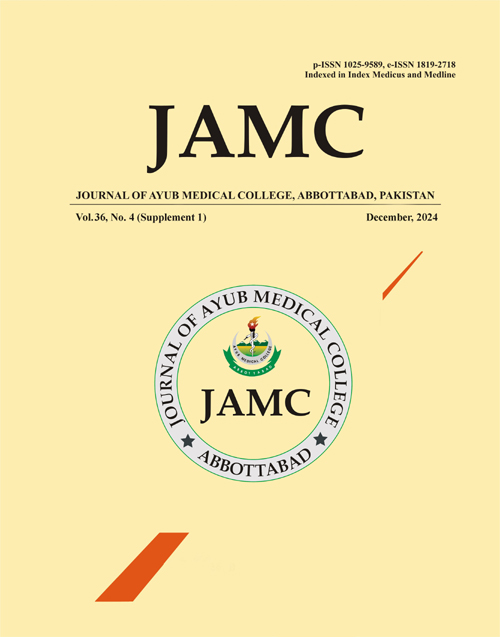COMPARISON OF EARLY NEEDLE-KNIFE SPHINCTEROTOMY VS STANDARD BILIARY CANNULATION IN PREVENTING ERCP ASSOCIATED PANCREATITIS IN CASES OF DIFFICULT BILIARY CANNULATION -A TERTIARY CARE EXPERIENCE
DOI:
https://doi.org/10.55519/JAMC-S4-13953Keywords:
Keywords: bile duct stone, ERCP, needle-knife sphincterotomy, pancreatitis.Abstract
Background: Post-ERCP pancreatitis (PEP) has been shown to increase by difficult biliary cannulation during ERCP. Increasingly used as an alternative to standard biliary cannulation to prevent this complication in difficult access cases is early needle-knife sphincterotomy (NKS). Objectives were to evaluate the efficacy of early needle knife sphincterotomy vs standard biliary cannulation in preventing post-ERCP pancreatitis in patients who have difficult biliary cannulation. This retrospective study was conducted at the Department of Gastroenterology and Hepatology, Pak Emirates Military Hospital from January to December 2022. Methods: Hundred patients who have difficult biliary cannulation in their ERCP were included. Patients were randomized, based on the attending endoscopist, to early NKS or standard biliary cannulation methods. The rate of PEP, procedure time and cannulation success rates were compared between the two groups. Results: It involved 100 patients with an average age of 50.3 years (±13.5) PEP occurred in 8% of the NKS group vs. 15% in the standard group (p=0.04). NKS group: significantly less time in procedure (mean 30 minutes) than the standard group (mean 45 minutes) (p=0.01). Conclusion: Early needle knife sphincterotomy, decreases risk of post-ERCP pancreatitis and procedure time compared to standard biliary cannulation. Thus, NKS represents a novel technique for early salvage of difficult cannulations.
References
1. Freeman ML, Guda NM. Prevention of post-ERCP pancreatitis: a comprehensive review. Gastrointest Endosc 2004;59(7):845–64.
2. Loperfido S, Angelini G, Benedetti G, Chilovi F, Costan F, De Berardinis F, et al. Major early complications from diagnostic and therapeutic ERCP: a prospective multicenter study. Gastrointest Endosc. 1998;48(1):1–10.
3. Berry R, Han JY, Tabibian JH. Difficult biliary cannulation: Historical perspective, practical updates, and guide for the endoscopist. World J Gastrointest Endosc 2019;11(1):5.
4. Maple JT, Ikenberry SO, Anderson MA, Appalaneni V, Decker GA, Early D, et al. The role of endoscopy in the management of choledocholithiasis. Gastrointest Endosc. 2011;74(4):731–44.
5. Testoni PA, Mariani A, Giussani A, Vailati C, Masci E, Macarri G, et al. Risk factors for post-ERCP pancreatitis in high- and low-volume centers and among expert and non-expert operators: a prospective multicenter study. Am J Gastroenterol 2010;105(8):1753–61.
6. Trikudanathan G, Navaneethan U, Parsi MA. Endoscopic management of difficult common bile duct stones. World J Gastroenterol 2013;19(2):165–73.
7. Dumonceau JM, Andriulli A, Elmunzer BJ, Mariani A, Meister T, Deviere J, et al. Prophylaxis of post-ERCP pancreatitis: European Society of Gastrointestinal Endoscopy (ESGE) guideline—updated June 2014. Endoscopy. 2014;46(9):799–815.
8. Freeman ML, DiSario JA, Nelson DB, Fennerty MB, Lee JG, Bjorkman DJ, et al. Risk factors for post-ERCP pancreatitis: a prospective, multicenter study. Gastrointest Endosc 2001;54(4):425–34.
9. Prat F, Meduri B, Ducot B, Chiche R, Salimbeni-Bartolini R, Pelletier G. Prediction of common bile duct stones by noninvasive tests. Ann Surg. 1999;229(3):362–8.
10. Baillie J. Needle-knife papillotomy. Gastroenterol Hepatol (N Y) 2010;6(12):759–61.
11. Sundaralingam P, Masson P, Bourke MJ. Early precut sphincterotomy does not increase risk during endoscopic retrograde cholangiopancreatography in patients with difficult biliary access: a meta-analysis of randomized controlled trials. Clin Gastroenterol Hepatol 2015;13(10):1722–1729.e2.
12. Bailey AA, Bourke MJ, Kaffes AJ, Byth K, Lee EY, Williams SJ. Needle-knife sphincterotomy: factors predicting its use and the relationship with post-ERCP pancreatitis (with video). Gastrointest Endosc 2010;71(2):266–71
13. Ikeda Y, Ono M, Ohmori G, Ameda S, Arihara Y, Yamada M, et al. Clinical benefit of early precut sphincterotomy for difficult biliary cannulation during endoscopic retrograde cholangiopancreatography. Surg Endosc. 2023;37(1):120–6.
14. Bapaye J, Chandan S, Bhalla V, Shehadah A, Mohan B, Ramai D, et al. Primary needle-knife fistulotomy versus rescue precut: a systematic review and meta-analysis of outcomes. iGIE 2023;2(1):44–51.
15. Navaneethan U, Konjeti R, Venkatesh PG, Sanaka MR, Parsi MA. Early precut sphincterotomy and the risk of endoscopic retrograde cholangiopancreatography-related complications: an updated meta-analysis. World J Gastrointest Endosc 2014;6(5):200.
16. Liao WC, Angsuwatcharakon P, Isayama H, Dhir V, Devereaux B, Khor CJ, et al. International consensus recommendations for difficult biliary access. Gastrointest Endosc. 2017;85(2):295–304.
17. Cote GA, Ansstas M, Shah S. Needle-knife papillotomy in difficult biliary cannulation: The University of Chicago experience. Am J Gastroenterol 2010;105(11):2391–2397.
Downloads
Published
How to Cite
Issue
Section
License
Copyright (c) 2024 Dr Muhammad Bilal Khattak khattak, Dr Ehtisham Haider, Dr Muhammad Hafeez, Dr Khawar Shabir, Dr Rafiudin, Hafizullah Khan

This work is licensed under a Creative Commons Attribution-NoDerivatives 4.0 International License.
Journal of Ayub Medical College, Abbottabad is an OPEN ACCESS JOURNAL which means that all content is FREELY available without charge to all users whether registered with the journal or not. The work published by J Ayub Med Coll Abbottabad is licensed and distributed under the creative commons License CC BY ND Attribution-NoDerivs. Material printed in this journal is OPEN to access, and are FREE for use in academic and research work with proper citation. J Ayub Med Coll Abbottabad accepts only original material for publication with the understanding that except for abstracts, no part of the data has been published or will be submitted for publication elsewhere before appearing in J Ayub Med Coll Abbottabad. The Editorial Board of J Ayub Med Coll Abbottabad makes every effort to ensure the accuracy and authenticity of material printed in J Ayub Med Coll Abbottabad. However, conclusions and statements expressed are views of the authors and do not reflect the opinion/policy of J Ayub Med Coll Abbottabad or the Editorial Board.
USERS are allowed to read, download, copy, distribute, print, search, or link to the full texts of the articles, or use them for any other lawful purpose, without asking prior permission from the publisher or the author. This is in accordance with the BOAI definition of open access.
AUTHORS retain the rights of free downloading/unlimited e-print of full text and sharing/disseminating the article without any restriction, by any means including twitter, scholarly collaboration networks such as ResearchGate, Academia.eu, and social media sites such as Twitter, LinkedIn, Google Scholar and any other professional or academic networking site.










